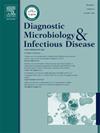曼氏血吸虫多肽作为免疫诊断候选物的免疫信息学预测和表征。
IF 2.1
4区 医学
Q3 INFECTIOUS DISEASES
Diagnostic microbiology and infectious disease
Pub Date : 2024-11-28
DOI:10.1016/j.diagmicrobio.2024.116632
引用次数: 0
摘要
血吸虫病是一种全球分布的被忽视的热带病,曼氏血吸虫是血吸虫病的重要病原。虽然加藤-卡茨技术在该病高流行地区是一种有效的诊断工具,但在患病率较低的地区缺乏敏感性。本研究的目的是鉴定和验证新的免疫原性肽靶点,这些靶点来自曼氏链球菌蛋白质组。从WormBase数据库中获得最初的14,499个预测序列,通过去除缺乏启动或停止密码子、短于100个氨基酸或氨基酸不确定的蛋白质,筛选出8,308个预测序列。然后交叉参考这些序列的交叉反应性,并根据b细胞免疫原性进行排序,从而选择442个肽进行合成和筛选。免疫印迹检测发现了22种反应性肽,其中15种对初始感染(T0)阶段的个体血清具有特异性,5种对T0和治疗后(30D)阶段的血清都有反应。随后,通过分子量评估对19条肽进行进一步验证,并合成用于ELISA检测。多肽池在感染个体中的反应频率为54.5%,超过了单个肽的反应频率。根据感染强度对反应活性最高的6个多肽进行分析。在低强度病例中,多肽池的反应性最高(65.2%)。ROC曲线分析显示,Peptide 15的敏感性最高(78.79%),特异度最高(87.5%),而多肽库的敏感性为67.65%,特异度为81.82%。这些发现突出了基于肽的诊断在加强血吸虫病检测和控制方面的潜力。本文章由计算机程序翻译,如有差异,请以英文原文为准。
Immunoinformatic predictions and characterization of Schistosoma mansoni peptides as candidates for immunodiagnostic
Schistosoma mansoni represents a significant etiological agent of schistosomiasis, a neglected tropical disease with a global distribution. Although the Kato-Katz technique is an effective diagnostic tool in areas with a high prevalence of the disease, it lacks sensitivity in regions with lower prevalence. The objective of this study was to identify and validate novel immunogenic peptide targets derived from the S. mansoni proteome. The initial set of 14,499 predicted sequences were obtained from the WormBase database, and it was filtered to 8,308 by removing proteins lacking start or stop codons, shorter than 100 amino acids, or with undetermined amino acids. The sequences were then cross-referenced for cross-reactivity and ranked based on B-cell immunogenicity, resulting in the selection of 442 peptides for synthesis and screening. Immunoblotting revealed 22 reactive peptides, with 15 exhibiting specificities for sera from individuals at the initial infection (T0) stage and five reactive to both T0 and post-treatment (30D) sera. Subsequently, 19 peptides were subjected to further validation through molecular weight assessment and synthesized for ELISA testing. The multi-peptide pool demonstrated a reactivity frequency of 54.5 % in infected individuals, which surpassed the reactivity frequencies observed for individual peptides. The six peptides exhibiting the highest reactivity were subsequently analyzed according to infection intensity. The multi-peptide pool exhibited the highest reactivity (65.2 %) in low-intensity cases. ROC curve analysis indicated that Peptide 15 demonstrated the highest sensitivity (78.79 %) and specificity (87.5 %), while the multi-peptide pool exhibited 67.65 % sensitivity and 81.82 % specificity. These findings highlight the potential of peptide-based diagnostics to enhance the detection and control of schistosomiasis.
求助全文
通过发布文献求助,成功后即可免费获取论文全文。
去求助
来源期刊
CiteScore
5.30
自引率
3.40%
发文量
149
审稿时长
56 days
期刊介绍:
Diagnostic Microbiology and Infectious Disease keeps you informed of the latest developments in clinical microbiology and the diagnosis and treatment of infectious diseases. Packed with rigorously peer-reviewed articles and studies in bacteriology, immunology, immunoserology, infectious diseases, mycology, parasitology, and virology, the journal examines new procedures, unusual cases, controversial issues, and important new literature. Diagnostic Microbiology and Infectious Disease distinguished independent editorial board, consisting of experts from many medical specialties, ensures you extensive and authoritative coverage.

 求助内容:
求助内容: 应助结果提醒方式:
应助结果提醒方式:


